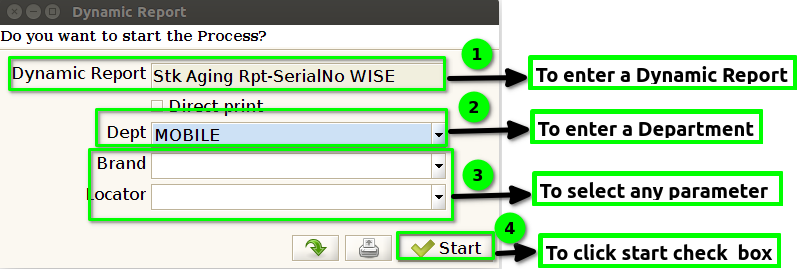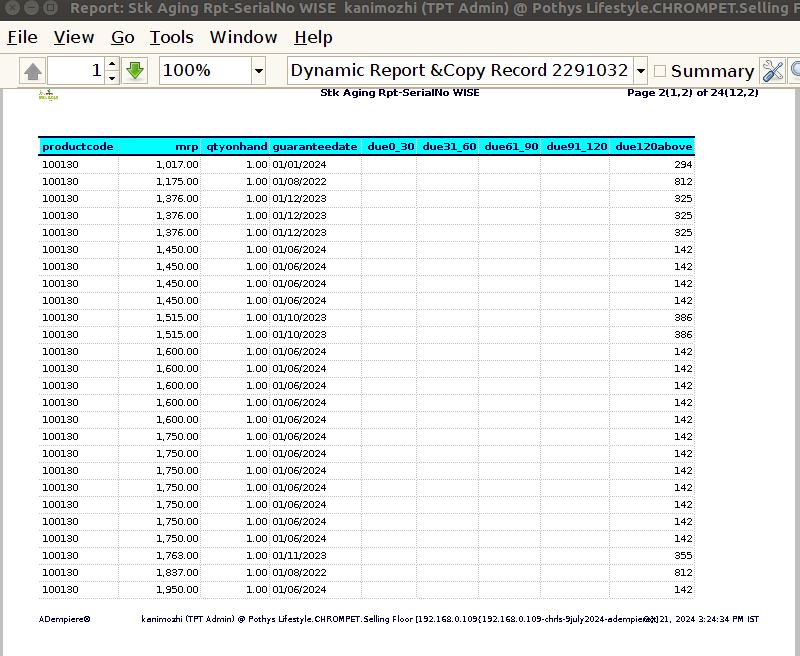TO CREATE A STOCK AGING REPORT-IMEI WISE-LS
A Stock Aging Report (IMEI Wise) is a tool used primarily in industries that deal with mobile devices and electronics, particularly in inventory management. Stock Aging,IMEI,Report,Inventory Management,Operational Efficiency,Sales Insights,IMEI Number: Unique identifier for each device. Quantity on Hand,Aging Period: Time duration since the item was added to inventory (e.g., 0-30 days, 31-60 days, etc.). – Status: Indicating whether the item is actively selling, stagnant, or obsolete.
User Access
Who Can Access
- Pothys admin
- Head cashier
- Sales Manager
- manager
What User Can Do
- View Reports
- Stock Aging Report-IMEI WISE.
Pre-Requisite Activities
- Locator
- Dynamic Report
- Product Department
- Brand
Business Rules
- IMEI Tracking – Every device in stock must be assigned a unique IMEI number for tracking.IMEI should be recorded at the point of receipt and linked to inventory records.
- Age Calculation – The age of stock is calculated from the date of receipt (or purchase) of the device.Aging categories may include: – 0-30 days (New) – 31-60 days (Slightly Aged) – 61-90 days (Aged) – 91+ days (Obsolete) .
- Inventory Classification – Stock must be classified into active and inactive based on sales history and aging. Devices not sold within 90 days should be flagged for review.
- Reorder Levels – Set minimum reorder levels for each IMEI based on historical sales data to avoid overstocking.Notify inventory managers when stock levels fall below the defined threshold.
- Disposal Rules – Devices aged over a certain period (e.g., 180 days) may be subject to liquidation or disposal processes.Proper documentation and compliance must be ensured for the disposal of obsolete stock.
- Reporting Frequency– The Stock Aging Report should be generated monthly to assess inventory health.Ad-hoc reports can be generated for specific IMEI ranges or categories upon request.
- Data Accuracy – Ensure regular audits of inventory records to maintain data accuracy regarding IMEI assignments and stock levels.Reconcile discrepancies between physical stock counts and reported figures.
- Sales Monitoring– Monitor sales velocity of IMEI stock to identify slow-moving items. – Implement promotional strategies for aged stock to encourage sales.
- System Integration – Ensure that the inventory management system integrates seamlessly with sales data for real-time aging analysis. – Update stock aging status automatically based on sales activity.
- Stakeholder Notifications – Notify relevant stakeholders (e.g., inventory managers, sales teams) about stock aging status and actions required.Schedule regular review meetings to discuss aging inventory and action plans.
User Interface
STEP1: To select a Stock Aging Report-IMEI WISE.

STEP2: To enter a Dynamic Report field default update.And to enter a Department,then to select any parameter based on the requirement.Finally to click the start check box.To run the process.

STEP3: Once to complete the process,then to show the report based on given parameter.


STEP4: Product code: A product code is a unique identifier assigned to a specific product, used to distinguish it from others.SKU (Stock Keeping Unit): A code used by retailers to manage inventory. UPC (Universal Product Code): A barcode standard used for tracking products in stores.EAN (European Article Number): Similar to UPC but used internationally.
Product Name: A product name is the specific name given to a product to distinguish it from others in the market. It serves as a key part of branding and marketing, making it easier for customers to recognize and remember the product. A good product name can convey important information about the product, such as its function, benefits, or unique features. For example, “iPhone” identifies a specific line of smartphones made by Apple, while “Coca-Cola” refers to a popular soft drink.
Brand Name:A single product having a multiple brand. A brand name is the name given to a company, product, or service that sets it apart from competitors. It represents the identity and reputation of the brand and is often associated with specific qualities, values, and experiences. A strong brand name can enhance customer recognition and loyalty. For example, “Nike” is a brand name known for athletic footwear.
Product design: Product design is the process of creating a new product or improving an existing one with a focus on functionality, aesthetics, and user experience.
Product color: Product color refers to the specific hue or combination of hues used in the design and branding of a product.
Serial no: A serial number is a unique identifier assigned to an individual item or product, allowing for its identification and tracking.
IMEI: IMEI stands for International Mobile Equipment Identity. It is a unique 15-digit number assigned to mobile devices, such as smartphones and tablets.
MRP:MRP stands for Material Requirements Planning. It is a production planning, scheduling, and inventory control system used to manage manufacturing processes. The main goals of MRP are to ensure that materials and products are available for production and delivery while minimizing inventory costs.
Onhand Qty:On-hand quantity” (often abbreviated as “on-hand qty”) refers to the actual number of units of a specific item that are physically available in inventory at a given time.On-hand quantity is typically updated regularly through inventory counts and management systems to reflect any changes due to sales, returns, or new stock arrivals.
Guarantee date: The guarantee date refers to the specific date until which a product is guaranteed to function properly or meet certain quality standards, as specified by the manufacturer or seller. This date is often linked to the product’s warranty period. Warranty Coverage- Indicates the duration of protection against defects or failures, typically starting from the purchase date.Customer Assurance- Provides customers with confidence that they can seek repairs, replacements, or refunds if the product fails within this period.Expiration-After the guarantee date, the warranty coverage usually ends, and customers may need to pay for repairs or support.
Training Videos
FAQ
SOP